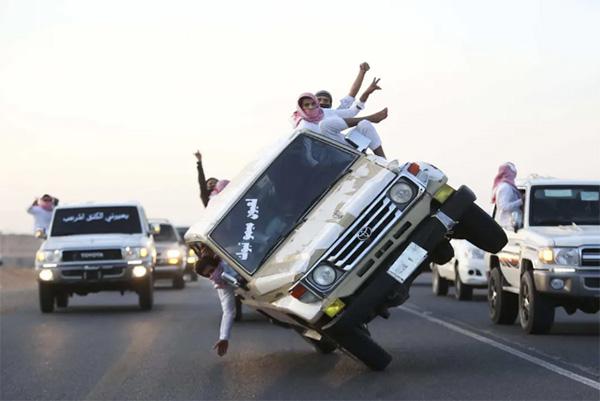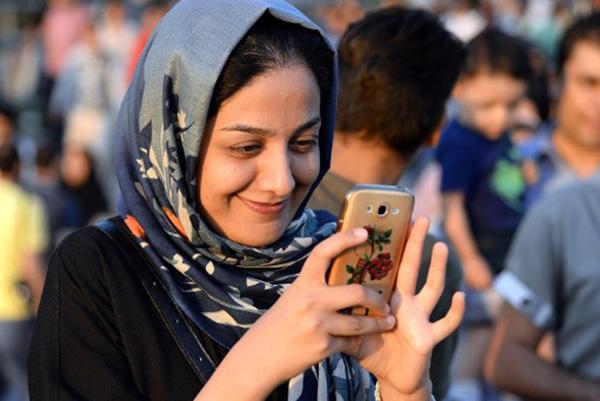Youth Subcultures in the Middle East

By Alivia Kiefer
An older man steps into the frame carrying an ‘oud, the traditional stringed instrument of Iraq, and kneels. Behind him, two people dressed in US military uniforms dance humorously to the emerging beat. The two “soldiers” walk over to the patterned rug that the older man is on, and upon which Iraqi rapper I-NZ is now kneeling. Suddenly the partying soldiers snap to attention and focus on IN-Z who had been listening to the man play his ‘oud. They force I-NZ into a standing position. In place the traditional thobe he had been wearing, he is now in an orange prison jumpsuit. The soldiers put a gun in his hand, aim it at the old man and pull the trigger, a clear reference to American artist Donald Glover’s song “This is America”. The lyrics begin: “This is Iraq”.
The music video appears lighthearted in the beginning, but the symbolic actions and lyrics tell a different story. I-NZ describes bombings, corruption, drug addiction, imprisonment, abuse, media censorship, and military occupation along with the beat. The refrain “This is not a party. Party just for you. . . ” underscores the license and casualness with which American occupiers committed brutal acts on Iraqis. IN-Z references an infamous picture of sexual abuse of prisoners at Abu Ghraib imitating one of the soldier’s poses after he says the word, “rape.” The song ends with two soldiers carrying a banner that says, “Mission Accomplished” and a man wearing a mask of former president George W. Bush standing proudly underneath. The old ‘oud player then recites poetry in classical Arabic to IN-Z as a prisoner sweeps up a liquid on the floor that is coming from the oil barrels but appears dark red.
I-NZ and many other youth artists in the Middle East offer windows into local culture and an opportunity for immense self-reflection for viewers in the West. Many were born into military conflict and Islamization. Others watched as their communities struggled to adapt to globalization despite a recall of cultural tradition and heritage. The experiences of young people in the Middle East cannot be defined in simple terms. Each nation, ethnic group, and community understand the events that shaped their circumstances from a local perspective while also expressing critiques from a global perspective. The history of American occupation in Iraq is one such example. I-NZ, via the Glover reference, points out striking parallels between injustices in Iraq and in the U.S. that ought to give Americans pause.
Youth subcultures offer participants an avenue of self-expression outside of their normal surroundings involving family, work, home, and schools. Subcultures allow these differences in identity to manifest themselves into a communal activity or group experience. A subculture is a group within a larger culture that has beliefs or interests that may vary from the larger social culture (O’Connor, 2004). Modern academia primarily focuses on issues in the Middle East regarding the state rather than through the perspectives of young people. Perhaps military and humanitarian issues seem more pressing. However, it is imperative we ask why concerns of daily life, such as those of youth, are overlooked. Perhaps the fact they are a reaction and a protest to what is happening in the world around them is the very reason that they are often ignored.
Many of the young people participating in the development of these subcultures are the same people who will be leading their nations in the future. Subcultures may therefore demonstrate how future leaders might think and respond to both domestic and global affairs. The following examples were chosen to shed light on a wide range of protests young people are expressing in the Middle East, going against economic hardship, political repression, and suppression of self-expression.
In 2006, Saudi citizen Mish’al al-Sharari died in a car accident in the low-income district (al-dakhl al-mahdūd) of Riyadh (Herrera & Bayat, 2010, p. 77). Sharari died during a “car skid session” (or Tafhit), as one of about 300 “car skidders” in Saudi Arabia (mufahhat). This is a practice also known as drifting in other areas of the world and it emerged as a subculture in Saudi Arabia in the early 1980s in response to an economic boom and urbanization of the country. Scholar and author of Joyriding in Riyadh: Oil, Urbanism, and Road Revolt Pascal Menoret stated that, “The extreme road revolt of Saudi youth was neither exceptional nor peripheral. It was a spectacular response to the global emergence of oil-based spaces.” Furthermore, the Guardian explained in 2014 that “in a country where youth unemployment stands at more than 30%, and where who you know is far more important than what you know, joyriding has become one way to express their anger and frustration.”

Sharari’s death was immensely important to Saudi youth because the subculture of joyriding and drifting has developed both on and offline in recent years, amassing large audiences both physical and virtual. The main participants in the actual drifting are aged 15 to 30, unemployed men from middle-to-lower class backgrounds (Herrera & Bayat, 2010, p. 80). The Ministry of Islamic Affairs and the Ministry of Interior have launched several eradication campaigns since the end of the 1990s, and media institutions are regularly responsible for denouncing Tafhit, calling it “street terrorism”. Despite these efforts, the Tafhit fans are still successful in recruiting their participants and audiences in school areas. One ninth-grade pupil told interviewers: “At the beginning of middle school, Tafhit fans distribute master keys to the pupils, the keys we use to steal cars. I remember this one day, I was walking back home and I saw two pupils, new ones. They said they wanted to steal a car; they had a key. That’s their way of recruiting people; they distribute keys to the pupils” (Herrera & Bayat, 2010, p. 82). The experiences of this student demonstrate how the Tafhit procure the vehicles they use in their shows, and also how they involve people from a very young age.
Young people in Riyadh explain their interest in Tafhit by the word ṭufush. Herrera and Bayat corroborate by stating, “rather than vacuum or boredom, ṭufush denotes the feeling of social impotence that overwhelms young people when they realize the incommensurable distance between the economic and social opportunities of Riyadh, the capital of the richest state in the region, and their own condition (unemployment or low income, split-up families because of rural migration, poor housing, and so on).” It is the unfair distance between their hopes and dreams and the reality of achieving them. Through drifting, tricks, and elaborate shows, the youth of Saudi Arabia have formed a subculture around cars that does not exist for the adults, or the larger Saudi cultures. For the Tafhit, their shows are an act of rebellion against what they perceive to be the socioeconomic injustices in their daily lives.
While young people in Riyadh find resistance in Tafhit, young people in Palestine have found liberation in alternative music. According to B’Tselem, a non-profit organization examining the conflict, 2,188 Palestinian children have been killed by Israeli forces since the conflict began, and 139 Israeli children have been killed by Palestinians. This places an immense discrepancy between the youth of both sides and forces Palestinian children to confront their own mortality at a young age. At first glance, raves taking place in downtown Haifa seem to relay no political or unifying messages–to the average onlooker, these raves are simply loud music, flashing lights, and drugs, if one chooses not to investigate deeper. To the ravers, however, they are a form of liberation and an unspoken expression of Palestinian identity.

One partygoer explained there is no longer a need to “emphasize the Palestinian character of these events”, because everyone already knows what they are there for (Karkabi, 2020, p. 690). Instead, they use the word “taharrur”, translated as: self-liberation as personal endeavor or association. In order to be liberated from Israeli occupation as a whole, “we first have to liberate ourselves and national liberation will come”, explained a queer Palestinian DJ. A musician from Ramallah furthers this by explaining that “we have to liberate ourselves from the idea of having to be free. We are free. There is only an appearance of occupation” (Karkabi, 2020, p. 691).
The voices of young Palestinians offer a message of specific importance here. They depict a different path to liberation than the violence that dominates international news about Palestine. Raving as a subculture is not mere partying but a form of activism for young Palestinians. It differs from the traditions of the larger culture of rebellion because it is based in self-liberation. This, of course, faces immense criticism from conservative Palestinians and national activists, who have referred to the ravers as, “a bunch of [useless and decadent] lutkhan (sissies)” (Karkabi, 2020, p. 693). Raves in Palestine carry the same risks as they do everywhere else, as situations can become extremely dangerous in a short period of time. This can happen through difficulties with crowd control, the frequent use of illicit “party drugs'', or issues such as dehydration and overheating. However, despite these risks, many young Palestinians have found their most tangible contributions to the resistance to be through EDM music and taharrur.
Young Iranian women have found similar liberation through the creativity and activism they have been able to express on the internet in the last two decades. This is not to say women or Iranian citizens have full, free access to the internet, though. In 2014, a young couple made a music video to Pharrel Williams’s song “Happy” and were sentenced by Iranian courts to a year in prison. Similarly, an eighteen-year-old girl was arrested in 2018 for posting a dancing video to Instagram (Koo, 2020). Iranian authorities have begun to associate girls’ internet freedom with anti-islamic activity, and thus have become another barrier Iranian women face imposed by the government. Despite this development, young Iranian women have still made significant social progress and have demonstrated resistance to oppression through online activity. Networks of women’s’ campaigns have been created online such as One Million Signatures, Meydaan Zanan, the Feminist School, Focus on Iranian Women, and My Stealthy Freedom in order to oppose things like compulsory hijab wearing.

The internet space is valuable for Iranian women because it allows them to unite with both women at home in Iran and women abroad to further their rights and education in an effective manner. It has become a subculture from the larger culture of women’s resistance in Iran because it revolves around the internet and has formed its own styles and norms. Fandoms, or internet-based groups of dedicated fans, have become a key part of Iranian women's freedom on the internet because it allows them to become increasingly involved with foreign cultures and experiences. For example, K-Pop, or the internet craze surrounding Korean popular music, has become a widely enjoyed pastime for Iranian women and has allowed them to challenge the gender expectations and views on women's sexuality in Iranian society. Internet access and activism as a subculture for Iranian women has faced increasing pushback from the Iranian government, but remains an imperative tool for women to create social change in the nation.
Whether it be drifting cars or posting dancing videos online, these subcultures represent acts of rebellion and dissent, whether against dominant culture or the government or their situations of occupation. The phenomena may appear as mere examples of teenage rebellion, and they indeed express teenage angst in many cases. However, the youth in these three examples are rebelling against more than just a curfew, or a case of strict parents. These young people are rebelling against structural issues that plague their lives and cast shadows on their futures. Indeed, the injustices form a worldwide motif across multiple subcultures. Young people come together to support common ideas and form movements to change the norms of society, their legal enforcements, and outside influences on their communities. As the above examples show, it is quite impossible to predict the next subculture that will emerge; however, it is certain that it will be based in resistance.
References
“Database on Fatalities and House Demolitions”. B’Tselem. https://statistics.btselem.org/en/all-fatalities/by-date-of-incident?section=minors&tab=overview.
Herrera, L., & Bayat, A. (Eds.) (2010). Being Young and Muslim: New Cultural Politics in the Global South and North. Oxford University Press. https://doi.org/10.1093/acprof:oso/9780195369212.001.0001
Karkabi, N. (2020). Self-Liberated Citizens: Unproductive Pleasures, Loss of Self, and Playful Subjectivities in Palestinian Raves. Anthropological Quarterly 93(4), 679-708. doi:10.1353/anq.2020.0071.
Koo, G.Y. (2020). Riding the Korean Wave in Iran: Cyberfeminism and Pop Culture among Young Iranian Women. Journal of Middle East Women's Studies 16(2), 144-164. https://www-muse-jhu-edu.proxy.lib.ohio-state.edu/article/763443.
Menoret, Pascal. (2014). “Riyadh Rage: Inside Saudi Arabia’s Joyriding Craze”. The Guardian. https://www.theguardian.com/world/2014/jun/22/saudia-arabia-joyriding-cars-drifting-street-racing-riyadh-rage.
O’Connor, Alan. (2004). The Sociology of Youth Subcultures. Peace Review 16(4), 409-414. https://www.csub.edu/~mault/subcultures2.pdf.
Official I-NZ. (2018). THIS IS IRAQ (العراق) [video]. YouTube. https://www.youtube.com/watch?v=fvxZLKtkgiM.
